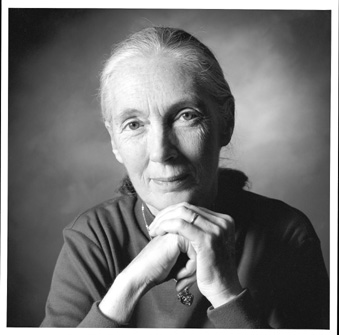Jane Goodall Reflects on Working Toward Peace
 As
we move into this millennium it is easy to be overwhelmed
by feelings of hopelessness. We humans have destroyed the
balance of nature: Forests are being destroyed, deserts
are spreading, there is terrible pollution of air, earth,
and water. Climate is changing, people are starving. There
are too many humans in some parts of the world, overconsumption
in others. There is human cruelty to "man" and
"beast"
As
we move into this millennium it is easy to be overwhelmed
by feelings of hopelessness. We humans have destroyed the
balance of nature: Forests are being destroyed, deserts
are spreading, there is terrible pollution of air, earth,
and water. Climate is changing, people are starving. There
are too many humans in some parts of the world, overconsumption
in others. There is human cruelty to "man" and
"beast"
alike; there is violence and war. Yet I do have hope. Let
me share my four reasons.
Firstly, we have at last begun to admit to the problems
that threaten the survival of life on earth. And we are
problem-solving creatures. Our amazing brains have created
modern technology, much of which has greatly benefited millions
of people around the globe. Sadly, along with our tendency
to overreproduce, it has also resulted in massive destruction
and pollution of the natural world. But can we not use our
awesome problem-solving ability to now find more environmentally
friendly ways to conduct our business? Good news: It's already
happening as hundreds of industries and businesses adopt
new "green" ethics. And we must play our part-in
our billions we must adopt less-harmful lifestyles. Refuse
to buy products from corporations that do not conform to
new environmental standards. We can change the world.
Secondly, nature is amazingly resilient. Given the chance,
poisoned rivers can live again. Deforested land can be coaxed-or
left-to blossom again. Animal species, on the verge of extinction,
can sometimes be bred and saved from a few individuals.
My third reason for hope lies in the tremendous energy,
enthusiasm, and commitment of young people around the world.
Young people want to fight to right the wrongs, for it will
be their world tomorrow-they will be the ones in leadership
positions, and they themselves will be parents. This is
why the Jane Goodall Institute started Roots & Shoots,
an environmental education and humanitarian program for
youth. Roots creep under the ground to make a firm foundation.
Shoots seem small, but to reach light they can break brick
walls. Hope-millions of roots and millions of shoots can
break through, break all the problems humans have created,
make change. Roots & Shoots groups, from kindergarten
to college, work to make the world a better place for animals,
the environment, and the human community. The central message
of Roots & Shoots is that every individual matters,
every individual has a role to play, every individual makes
a difference.
My fourth reason for hope lies in the indomitable nature
of the human spirit. There are so many people who have dreamed
seemingly unattainable dreams and, because they never gave
up, achieved their goals against all the odds, or blazed
a path along which others could
follow.
So let us move into this millennium with hope-with faith
in ourselves, in our intellect, in our indomitable spirit.
Let us develop respect for all living things. Let us try
to replace violence and intolerance with understanding and
compassion. And love.
A Note From Photographer Michael Collopy
When traveling, Jane shares "objects of hope"
with the people she meets. Among these is a shard of limestone
from Robin Island, where Nelson Mandela labored for seventeen
of his twenty-two years in prison. This shard remains a
potent symbol of what is possible, as Jane never thought
apartheid would end without bloodshed.
Another item is a simple wooden comb made by a Tanzanian
leper who lost all his fingers and toes before the disease
was checked. He weaves the strands of wool with his stumps
and teeth, decorating the combs so he can sell them and
live with dignity instead of begging.
Perhaps the most popular object is Jane's mascot, Mr. H,
the chimp shown here with the banana. Mr. H was made by
Gary Haun, who lost his eyesight at twenty-five while in
the U.S. Marines. Gary decided not to let his blindness
spoil his life and so became a magician who performs for
children. He is so
good that the children don't realize he's blind. Jane has
brought Mr. H to twenty-nine countries, and he has been
touched by more than 150,000 people.
Biography
Resources for Teachers
and Students